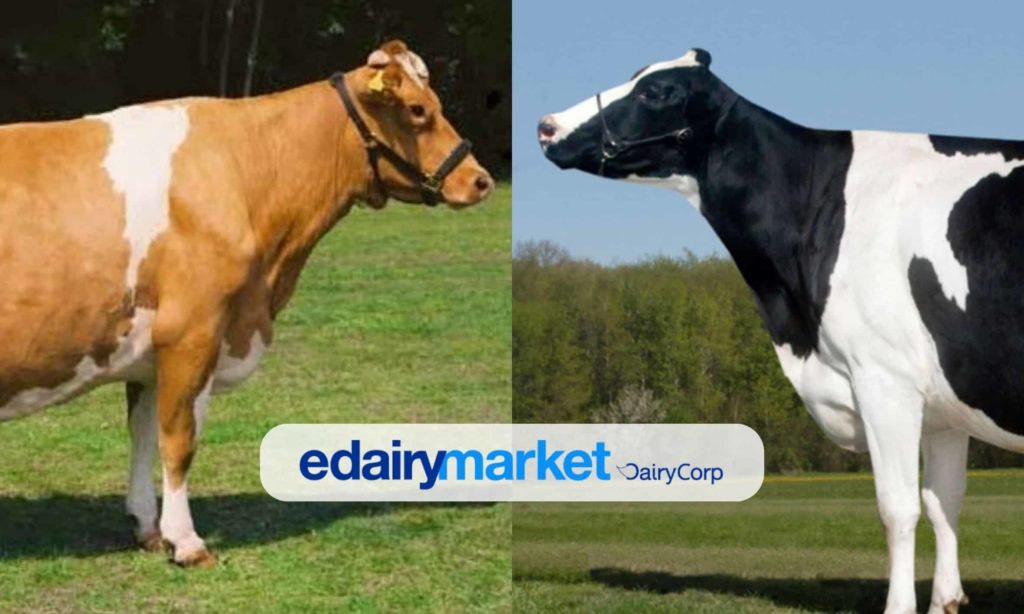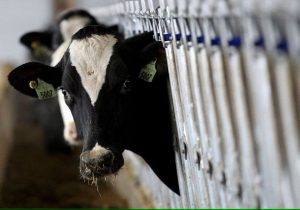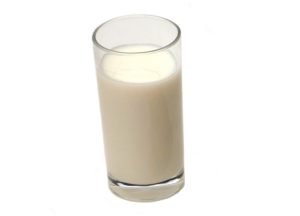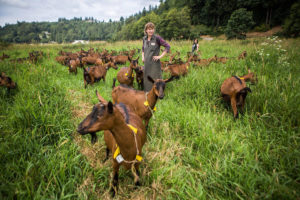Today eDairy Market tells you about Holstein and Guernsey cows, which are two different breeds of dairy cattle with very distinct characteristics.
Here are the 7 main differences between them:
1. Origin:
Holstein cows, also known as Holstein-Friesian cows, originate from the Netherlands. They are the most common and recognized dairy cattle breed worldwide. Guernsey cows, on the other hand, come from the Channel Islands, specifically from the island of Guernsey.
2. Appearance:
Holstein cows are known for their large size. They have a black and white or red and white coat. Their body is usually white with black or red spots. Guernsey cows are smaller than Holsteins. They have a reddish-brown or fawn coat with white spots on the body.
3. Milk production:
Holsteins are famous for their high milk production. They are considered the most productive dairy breed, producing large quantities of milk with relatively low butterfat and protein content. Guernsey cows, while not as prolific in milk production as Holsteins, still produce a respectable amount of milk. However, what sets Guernsey cows apart is their higher butterfat and protein content in milk, which makes them ideal for producing rich, flavorful dairy products.
4. Feed efficiency:
Holsteins are known for their exceptional feed efficiency. They can convert large amounts of feed into milk, making them efficient producers in terms of input/output ratio. Guernseys are also efficient, but require somewhat less feed than Holsteins due to their smaller size.
5. Temperament:
In terms of temperament, Holsteins tend to be more docile and calm. They tend to be easier to handle. Guernseys are also known for their gentle and friendly nature, but some may show a slightly more energetic or independent nature.
6. Adaptability:
Holsteins are very adaptable and can thrive in a variety of climates and management systems. They have been bred and selected for their adaptability to different environments. Guernsey cows are also adaptable, but are particularly well adapted to island environments and are known to be hardy and effective grazers.
7. Market demand:
Holsteins dominate the world dairy industry because of their high milk production and wide availability. Their milk is commonly used for liquid consumption, cheese production and other dairy products. Guernsey cows are less common and their milk is often sought after by consumers who prefer rich, high quality dairy products such as artisanal cheeses and ice cream.
8. Genetic variability:
The Holstein breed is bred for uniformity and constancy of traits, resulting in a relatively high degree of genetic similarity within the breed. This focused breeding has resulted in the breed’s exceptional milk production. The Guernsey, on the other hand, has a more diverse gene pool, with a wider range of genetic variability. This genetic diversity can be advantageous in terms of adaptability and resistance.


Solids and Liters:
Milk production:
Holstein: The Holstein is the most common dairy cattle breed worldwide and is famous for its exceptional milk production. On average, Holsteins produce 25 to 30 liters of milk per day, making them very efficient in terms of volume.
Guernsey: Guernseys, while not as prolific as Holsteins, are still known for their moderate to high milk production. On average, Guernseys produce 17 to 20 liters of milk per day.
Milk solids:
Holstein: Holstein milk has a lower butterfat content compared to other breeds. The average butterfat percentage of Holstein milk ranges from 3.2% to 3.6%. However, Holsteins tend to have higher milk volume, which translates into higher milk solids production overall.
Guernsey: Guernsey milk is famous for its high butterfat, protein and other milk solids content. The butterfat percentage of Guernsey milk can range from 4.5% to 5%, making it ideal for producing rich, creamy dairy products.
In summary, Holsteins are known for their exceptional milk production volume, while Guernseys excel at producing milk with higher butterfat content. Holsteins tend to produce more milk overall, while Guernseys offer lower milk volume but more milk solids.
✅ At eDairy Market we have all the dairy categories, all the products and all the companies. We represent you.
✅ Power your business through eDairy Market:
- Your microsite with products, brand and domain of your company at a minimum cost.
- You will be able to sell your products and we do not charge you commission per sale.
- Now you can sell your Products, Ingredients and Dairy Machinery in English, Spanish, Portuguese and Mandarin Chinese.
✅ Create your own online store in a super easy way:








